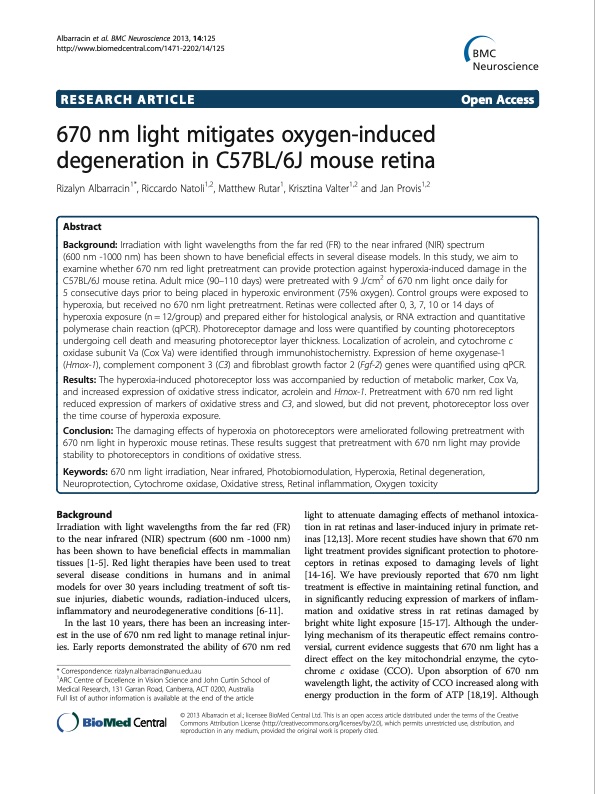
PDF Publication Title:
Text from PDF Page: 001
Albarracin et al. BMC Neuroscience 2013, 14:125 http://www.biomedcentral.com/1471-2202/14/125 RESEARCH ARTICLE 670 nm light mitigates oxygen-induced degeneration in C57BL/6J mouse retina Rizalyn Albarracin1*, Riccardo Natoli1,2, Matthew Rutar1, Krisztina Valter1,2 and Jan Provis1,2 Abstract Open Access Background: Irradiation with light wavelengths from the far red (FR) to the near infrared (NIR) spectrum (600 nm -1000 nm) has been shown to have beneficial effects in several disease models. In this study, we aim to examine whether 670 nm red light pretreatment can provide protection against hyperoxia-induced damage in the C57BL/6J mouse retina. Adult mice (90–110 days) were pretreated with 9 J/cm2 of 670 nm light once daily for 5 consecutive days prior to being placed in hyperoxic environment (75% oxygen). Control groups were exposed to hyperoxia, but received no 670 nm light pretreatment. Retinas were collected after 0, 3, 7, 10 or 14 days of hyperoxia exposure (n = 12/group) and prepared either for histological analysis, or RNA extraction and quantitative polymerase chain reaction (qPCR). Photoreceptor damage and loss were quantified by counting photoreceptors undergoing cell death and measuring photoreceptor layer thickness. Localization of acrolein, and cytochrome c oxidase subunit Va (Cox Va) were identified through immunohistochemistry. Expression of heme oxygenase-1 (Hmox-1), complement component 3 (C3) and fibroblast growth factor 2 (Fgf-2) genes were quantified using qPCR. Results: The hyperoxia-induced photoreceptor loss was accompanied by reduction of metabolic marker, Cox Va, and increased expression of oxidative stress indicator, acrolein and Hmox-1. Pretreatment with 670 nm red light reduced expression of markers of oxidative stress and C3, and slowed, but did not prevent, photoreceptor loss over the time course of hyperoxia exposure. Conclusion: The damaging effects of hyperoxia on photoreceptors were ameliorated following pretreatment with 670 nm light in hyperoxic mouse retinas. These results suggest that pretreatment with 670 nm light may provide stability to photoreceptors in conditions of oxidative stress. Keywords: 670 nm light irradiation, Near infrared, Photobiomodulation, Hyperoxia, Retinal degeneration, Neuroprotection, Cytochrome oxidase, Oxidative stress, Retinal inflammation, Oxygen toxicity Background Irradiation with light wavelengths from the far red (FR) to the near infrared (NIR) spectrum (600 nm -1000 nm) has been shown to have beneficial effects in mammalian tissues [1-5]. Red light therapies have been used to treat several disease conditions in humans and in animal models for over 30 years including treatment of soft tis- sue injuries, diabetic wounds, radiation-induced ulcers, inflammatory and neurodegenerative conditions [6-11]. In the last 10 years, there has been an increasing inter- est in the use of 670 nm red light to manage retinal injur- ies. Early reports demonstrated the ability of 670 nm red * Correspondence: rizalyn.albarracin@anu.edu.au 1ARC Centre of Excellence in Vision Science and John Curtin School of Medical Research, 131 Garran Road, Canberra, ACT 0200, Australia Full list of author information is available at the end of the article light to attenuate damaging effects of methanol intoxica- tion in rat retinas and laser-induced injury in primate ret- inas [12,13]. More recent studies have shown that 670 nm light treatment provides significant protection to photore- ceptors in retinas exposed to damaging levels of light [14-16]. We have previously reported that 670 nm light treatment is effective in maintaining retinal function, and in significantly reducing expression of markers of inflam- mation and oxidative stress in rat retinas damaged by bright white light exposure [15-17]. Although the under- lying mechanism of its therapeutic effect remains contro- versial, current evidence suggests that 670 nm light has a direct effect on the key mitochondrial enzyme, the cyto- chrome c oxidase (CCO). Upon absorption of 670 nm wavelength light, the activity of CCO increased along with energy production in the form of ATP [18,19]. Although © 2013 Albarracin et al.; licensee BioMed Central Ltd. This is an open access article distributed under the terms of the Creative Commons Attribution License (http://creativecommons.org/licenses/by/2.0), which permits unrestricted use, distribution, and reproduction in any medium, provided the original work is properly cited.PDF Image | 670 nm light mitigates oxygen-induced degeneration 2013

PDF Search Title:
670 nm light mitigates oxygen-induced degeneration 2013Original File Name Searched:
670nm-light-mitigates-oxygen-induced-degeneration-in-mouse-retina.pdfDIY PDF Search: Google It | Yahoo | Bing
Cruise Ship Reviews | Luxury Resort | Jet | Yacht | and Travel Tech More Info
Cruising Review Topics and Articles More Info
Software based on Filemaker for the travel industry More Info
The Burgenstock Resort: Reviews on CruisingReview website... More Info
Resort Reviews: World Class resorts... More Info
The Riffelalp Resort: Reviews on CruisingReview website... More Info
| CONTACT TEL: 608-238-6001 Email: greg@cruisingreview.com | RSS | AMP |